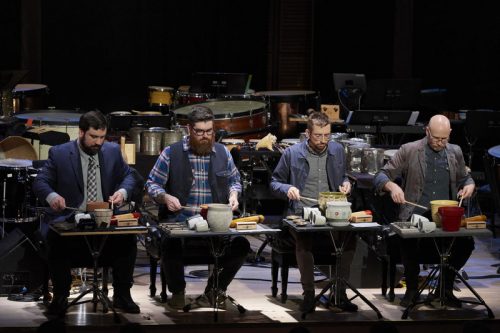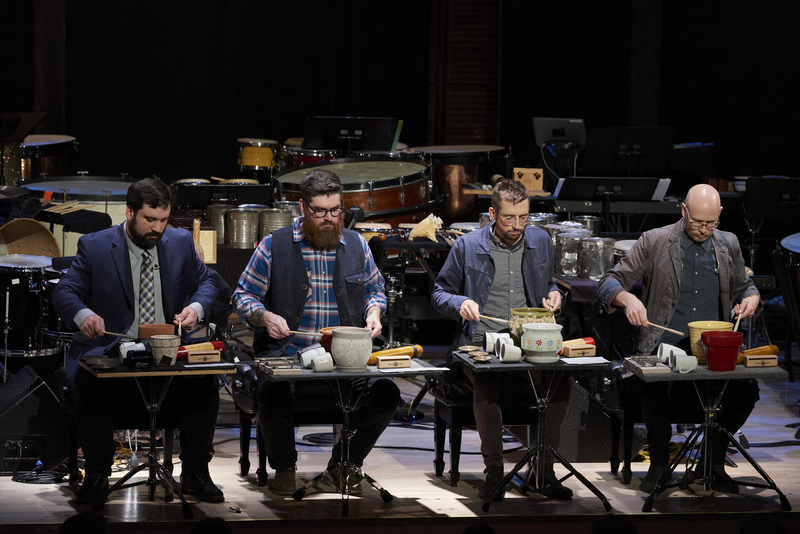 United States Beyer, Cage, Chávez, Lang, Reich, Trueman, Varèse, Wolfe, Xenakis: Sō Percussion (Eric Cha-Beach, Josh Quillen, Adam Sliwinski and Jason Treuting) and Friends. Zankel Hall, New York City, 7.12.2019. (DS)
United States Beyer, Cage, Chávez, Lang, Reich, Trueman, Varèse, Wolfe, Xenakis: Sō Percussion (Eric Cha-Beach, Josh Quillen, Adam Sliwinski and Jason Treuting) and Friends. Zankel Hall, New York City, 7.12.2019. (DS)

Varèse – Ionisation
Chávez – Largo, from Toccata for Percussion Instruments
Beyer – March for 30 Percussion Instruments
Cage – Third Construction
Xenakis – ‘Peaux’ from Pléïades
Lang – ‘part 3’ from the so-called laws of nature
Reich – Clapping Music
Trueman – ‘120bpm,’ from neither Anvil nor Pulley
Wolfe – Forbidden Love (New York premiere)
Guest percussionists: Kasey Blezinger, Shelby Blezinger-McCay, David Degge, Petra Elek, Amy Garapic, Todd Meehan, Doug Perkins, Yumi Tamashiro, Clara Warnaar
Like a train ride through a vast countryside, Sō Percussion sped by nearly 100 years of evolving modernist and post-modernist works, in this recent percussion tribute at Carnegie Hall.
The first four works were done without any breaks — an interesting choice. With full control at the helm of this virtual express train, the ensemble flew from Varèse to Chavez, through Beyer and into Cage. The journey was both phenomenal and revelatory. No instrument was left unbanged, unwhacked, unscraped, nor untapped. From the contrasting timbres of Ionisation to the bellowing conch shell announcing mid-century modernism in Third Construction, the Sō quartet and the many guest percussionists who joined them gracefully moved around a stage packed with instruments to put on one of the grandest performances — I would venture to say — ever staged.
Above and beyond the unquestionable talent that permeated every single work, the night’s most memorable takeaways were Xenakis’s ‘Peaux’ from Pleiades and the New York premiere of Wolfe’s Forbidden Love — the former with the quartet joined by Todd Meehan and Doug Perkins. All six musicians stood at drum sets around the back perimeter of the stage, enabling each to see each other and carefully synchronize the rhythmic challenges of the composer’s precisely placed overlapping patterns.
Like a mock marching band, Xenakis plays with our expectations of traditional, unison drumming by requiring each musician to follow the next with mere milliseconds of difference — while incorporating a vast continuum of dynamics. This strictness combined with elasticity creates a tense but exciting momentum that can feel like walking a tightrope, albeit with scattered moments of relief. In the wrong hands, this composition could sound like an onerous, misguided etude, but the players had no trouble imbuing it with expressive musicality, further affirming their place among new music’s foremost interpreters.
For the final work, the ensemble commissioned a new work by Julia Wolfe. They asked for a quartet and that is precisely what they got: a work for two violins, viola, and cello. But each instrument was transformed into a percussive machine, using mallets, long pieces of string, plucking, and technical feats of mastery with nimble fingers — at times, with thimbles. Wolfe’s variety of sounds seemed countless.
But the real profundity of Forbidden Love is not its experiment in re-purposing classical instruments, but the pervasive presence of American cultural imagery: sewing machines, wood chopping, quilting, square dancing, clogging, and hints of folk melody. The new and experimental became the framework in which a culture is reminded of its far-gone roots, long before a young man named Cage would prepare his piano.
Forbidden Love began subtly and, over the course of half an hour, increased in speed, volume, and intensity. Hearing this for the first time, I wondered if Wolfe would end on an unoriginal, rhythmic buildup after so much originality. This seemed so predictable that a few audience members began to clap when the ensemble reached a loud, finale-like climax. But instead, the musicians dropped to a silent pianissimo. Wolfe did have a trick up her sleeve (and this is where those thimbles come in). Suddenly, like hail on the roof of a prairie log cabin, all four musicians tapped the wood of each instrument in a fury of beautiful, sonorous clatter, elevating the effect to the truly inspired. The hall filled with the extraordinary timbre of furiously tapping fingers, as if reaching across time and experience. Wolfe’s choice of ending did her work justice and left anticipation in its wake. These feats of 20th and 21st-century percussion will ensure that the next 100 years will be equally exciting.
Daniele Sahr
